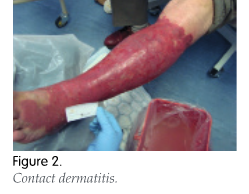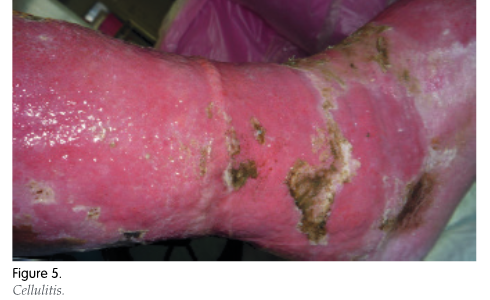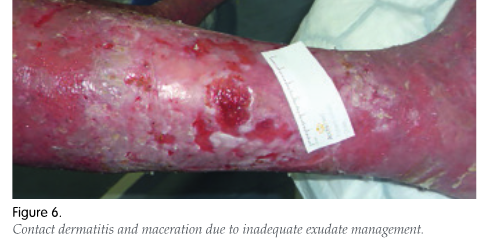References
Atkin L (2017) Cellulitis of the lower limbs: Diagnosis and management. Nurse Prescribing 15: 588–92
Atzori L, Manunza F, Pau M (2013) New trends in cellulitis. WMJ Dermatology 1: 64–76
Beldon P, Burton F (2005) Clinical Practice Guidelines. Management guidelines for lower limb cellulitis. Wounds UK: 16-22.
Bishop J, Jones M, Farquharson J, Summerhayes K, Tucker R, Smith M, et al (2021) Implementation of a cellulitis management plan in three Australian regional health services to address an evidence–practice gap in antibiotic prescribing. Antibiotics 10(1288): 1–12
British Lymphology Society ( 2016) Consensus Document on the Management of Cellulitis in Lymphoedema. Available online: www.lymphoedema.org/wp-content/uploads/2020/01/cellulitis_consensus.pdf
Cheong HS; Chang Y, Joo E-J, Cho A, Ryu S (2019) Metabolic obesity phenotypes and risk of cellulitis: a cohort study. J Clin Med 8(7): 953
Cox NH, Colver GB, Paterson WD (1998) Management and morbidity of cellulitis of the leg. J R Soc Med 91(12): 634–7
Cranendonk DR, Lavrijsen APM, Prins JM, Wiersinga WJ (2017) Cellulitis: current insights into pathophysiology and clinical management. Neth J Med 75(9): 366–78
English JSC (1997) Contact dermatitis. Medicine 25: 42–5
El-Daher N, Magnussen CR (1996) Skin and soft tissue infections: outpatient management and indications for hospitalisation. Consultant 36(12): 2563–6
Eriksson B, Jorup-Rönström C, Karkkonen K, Sjöblom AC, Holm SE (1996) Erysipelas: Clinical and bacteriologic spectrum and serological aspects. Clin Infect Dis 23(5): 1091–8
Hofman D (1998) Oedema and the management of venous leg ulcers. J Wound Care 7(7): 345–8
Huttunen R, Syrjänen J (2013) Obesity and the risk and outcome of infection. Int J Obes 37: 333–40
Jorup-Rönström C, Britton S (1987)Recurrent erysipelas: Predisposing factors and costs of prophylaxis. Infection 15(2): 105–6
Kilburn SA, Featherstone P, Higgins B, Brindle R (2010) Interventions for cellulitis and erysipelas. Cochrane Database Syst Rev (6): CD004299
Kish TD, Chang MH, Fung HB (2010) Treatment of skin and soft tissue infections in the elderly: A review. Am J Geriatr Pharmacother 8: 485–513
Levell NJ, Wingfield CG, Garioch JJ (2011) Severe lower limb cellulitis is best diagnosed by dermatologists and managed with shared care between primary and secondary care. Br J Dermatol 164: 1326–8
Lipsky BA, Tabak YP, Johannes RS, Vo L, Hyde L, Weigelt JA (2010) Skin and soft tissue infections in hospitalised patients with diabetes: culture isolates and risk factors associated with mortality, length of stay and cost. Diabetologia 53: 914–23
National Institute for Health and Care Excellence (2019) Cellulitis and erysipelas: antimicrobial prescribing (NG141). NICE, London
National Institute for Health and Care Excellence (2020) Venous eczema and lipodermatosclerosis. NICE, London
Pavlotsky F, Amrani S, Trau H (2004) Recurrent erysipelas: risk factors. J Dtsch Dermatol Ges 2(2): 89–95
Pereira de Godoy JM, Galacini Massari P, Yoshino Rosinha M, Marinelli Brandao R, Foroni Casas AL (2010) Epidemiological data and comorbidities of 428 patients hospitalized with erysipelas. Angiology 61: 492–4
Santer M, Lalonde A, Francis NA , Smart P, Hooper J, Teasdale E , Del Mar C, et al (2018) Management of cellulitis: current practice and research questions. Br J Gen Pract 68(677): 595–6
Strazzula L, Cotliar J, Fox LP, et al (2015) Inpatient dermatology consultation aids diagnosis of cellulitis among hospitalized patients: A multi-institutional analysis. J Am Acad Dermatol 73: 70–5
Tavadia S, Bianchi J, Dawe RS, et al (2003) Allergic contact dermatitis in venous leg ulcer patients. Contact Dermatitis 48(5): 261–5
Weller R, Hunter H, Mann M (2015) Clinical Dermatology. 5th edn. Wiley Blackwell, West Sussex
Weng QY, Raff AB, Cohen JM, et al (2017) Costs and consequences associated with misdiagnosed lower extremity cellulitis. JAMA Dermatol 153(2): 141–6
Wingfield C (2009) Clinical review. Lower limb cellulitis: a dermatological perspective. Wounds UK 5(2): 26–36
Yosipovitch G, DeVore A, Dawn A (2007) Obesity and the skin: skin physiology and skin manifestations of obesity. J Am Acad Dermatol 56: 901–16
Atzori L, Manunza F, Pau M (2013) New trends in cellulitis. WMJ Dermatology 1: 64–76
Beldon P, Burton F (2005) Clinical Practice Guidelines. Management guidelines for lower limb cellulitis. Wounds UK: 16-22.
Bishop J, Jones M, Farquharson J, Summerhayes K, Tucker R, Smith M, et al (2021) Implementation of a cellulitis management plan in three Australian regional health services to address an evidence–practice gap in antibiotic prescribing. Antibiotics 10(1288): 1–12
British Lymphology Society ( 2016) Consensus Document on the Management of Cellulitis in Lymphoedema. Available online: www.lymphoedema.org/wp-content/uploads/2020/01/cellulitis_consensus.pdf
Cheong HS; Chang Y, Joo E-J, Cho A, Ryu S (2019) Metabolic obesity phenotypes and risk of cellulitis: a cohort study. J Clin Med 8(7): 953
Cox NH, Colver GB, Paterson WD (1998) Management and morbidity of cellulitis of the leg. J R Soc Med 91(12): 634–7
Cranendonk DR, Lavrijsen APM, Prins JM, Wiersinga WJ (2017) Cellulitis: current insights into pathophysiology and clinical management. Neth J Med 75(9): 366–78
English JSC (1997) Contact dermatitis. Medicine 25: 42–5
El-Daher N, Magnussen CR (1996) Skin and soft tissue infections: outpatient management and indications for hospitalisation. Consultant 36(12): 2563–6
Eriksson B, Jorup-Rönström C, Karkkonen K, Sjöblom AC, Holm SE (1996) Erysipelas: Clinical and bacteriologic spectrum and serological aspects. Clin Infect Dis 23(5): 1091–8
Hofman D (1998) Oedema and the management of venous leg ulcers. J Wound Care 7(7): 345–8
Huttunen R, Syrjänen J (2013) Obesity and the risk and outcome of infection. Int J Obes 37: 333–40
Jorup-Rönström C, Britton S (1987)Recurrent erysipelas: Predisposing factors and costs of prophylaxis. Infection 15(2): 105–6
Kilburn SA, Featherstone P, Higgins B, Brindle R (2010) Interventions for cellulitis and erysipelas. Cochrane Database Syst Rev (6): CD004299
Kish TD, Chang MH, Fung HB (2010) Treatment of skin and soft tissue infections in the elderly: A review. Am J Geriatr Pharmacother 8: 485–513
Levell NJ, Wingfield CG, Garioch JJ (2011) Severe lower limb cellulitis is best diagnosed by dermatologists and managed with shared care between primary and secondary care. Br J Dermatol 164: 1326–8
Lipsky BA, Tabak YP, Johannes RS, Vo L, Hyde L, Weigelt JA (2010) Skin and soft tissue infections in hospitalised patients with diabetes: culture isolates and risk factors associated with mortality, length of stay and cost. Diabetologia 53: 914–23
National Institute for Health and Care Excellence (2019) Cellulitis and erysipelas: antimicrobial prescribing (NG141). NICE, London
National Institute for Health and Care Excellence (2020) Venous eczema and lipodermatosclerosis. NICE, London
Pavlotsky F, Amrani S, Trau H (2004) Recurrent erysipelas: risk factors. J Dtsch Dermatol Ges 2(2): 89–95
Pereira de Godoy JM, Galacini Massari P, Yoshino Rosinha M, Marinelli Brandao R, Foroni Casas AL (2010) Epidemiological data and comorbidities of 428 patients hospitalized with erysipelas. Angiology 61: 492–4
Santer M, Lalonde A, Francis NA , Smart P, Hooper J, Teasdale E , Del Mar C, et al (2018) Management of cellulitis: current practice and research questions. Br J Gen Pract 68(677): 595–6
Strazzula L, Cotliar J, Fox LP, et al (2015) Inpatient dermatology consultation aids diagnosis of cellulitis among hospitalized patients: A multi-institutional analysis. J Am Acad Dermatol 73: 70–5
Tavadia S, Bianchi J, Dawe RS, et al (2003) Allergic contact dermatitis in venous leg ulcer patients. Contact Dermatitis 48(5): 261–5
Weller R, Hunter H, Mann M (2015) Clinical Dermatology. 5th edn. Wiley Blackwell, West Sussex
Weng QY, Raff AB, Cohen JM, et al (2017) Costs and consequences associated with misdiagnosed lower extremity cellulitis. JAMA Dermatol 153(2): 141–6
Wingfield C (2009) Clinical review. Lower limb cellulitis: a dermatological perspective. Wounds UK 5(2): 26–36
Yosipovitch G, DeVore A, Dawn A (2007) Obesity and the skin: skin physiology and skin manifestations of obesity. J Am Acad Dermatol 56: 901–16







